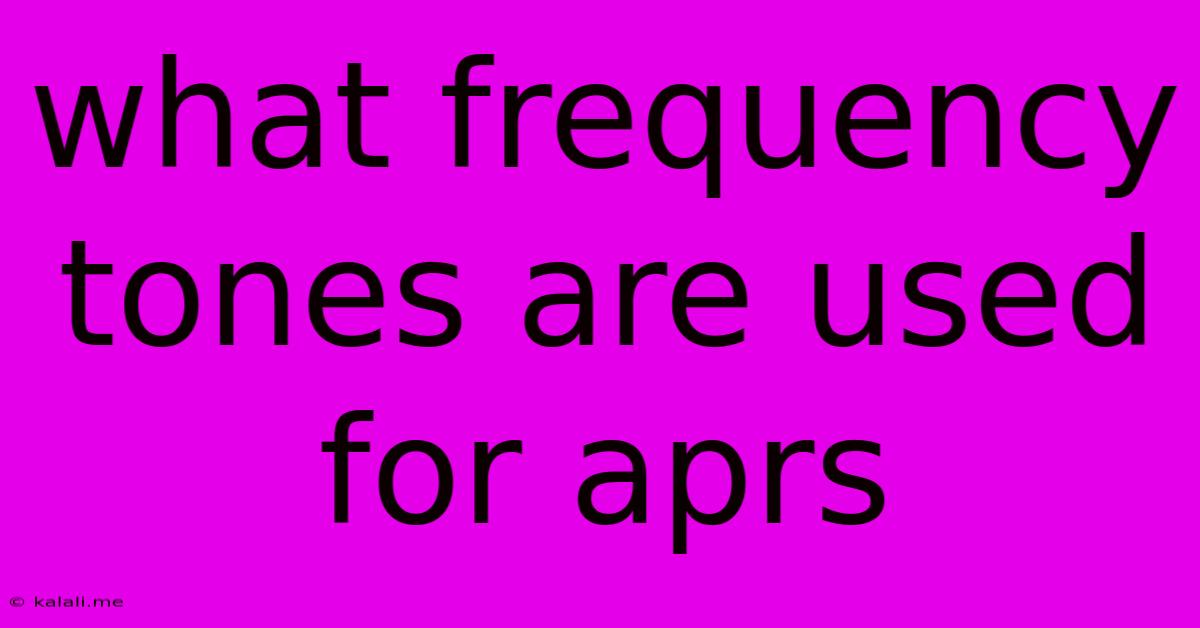What Frequency Tones Are Used For Aprs
Kalali
Jun 09, 2025 · 3 min read

Table of Contents
What Frequency Tones Are Used for APRS?
APRS, or Automatic Packet Reporting System, is a digital communication protocol used by amateur radio enthusiasts worldwide for tracking locations, sending messages, and exchanging weather information. Understanding the frequencies and tones used is crucial for successful APRS operation. This article will delve into the specifics of the tones used in APRS, clarifying common misconceptions and providing a comprehensive overview.
The core of APRS doesn't rely on a specific set of audio tones in the way some other radio systems do. Instead, APRS uses digital data transmission over existing amateur radio frequencies. This means the audio you hear (or don't hear) isn't directly related to the APRS data itself. The data is modulated onto a carrier wave, which is then transmitted.
However, the frequencies used are crucial, and they are allocated within the amateur radio bands. These frequencies vary by region and are subject to licensing regulations. You'll need to consult your local amateur radio regulations and licensing information to determine the appropriate frequencies for your location. Common frequencies used globally often fall within the 2-meter (144 MHz) and 70-centimeter (430 MHz) bands.
Understanding the Role of Sub-audible Tones (CTCSS/DCS)
While APRS doesn't inherently use audio tones for its data transmission, sub-audible tones (CTCSS/DCS) play a vital role in accessing the APRS network. These tones act as a filter, preventing unwanted interference from other transmissions on the same frequency. Think of them as digital "gatekeepers" allowing only signals with the correct tone to be received.
- CTCSS (Continuous Tone-Coded Squelch System): A common analog sub-audible tone system.
- DCS (Digital Code Squelch): A digital counterpart offering more tone options and better noise immunity.
Many APRS digipeaters (repeaters that forward APRS packets) use CTCSS/DCS to control access to the frequency. This means you'll need to configure your APRS transceiver or software to use the correct CTCSS/DCS tone to both transmit and receive APRS data through these repeaters. The specific tone used is usually indicated in the repeater's information. You'll often find this information on websites or databases dedicated to amateur radio repeaters. This often includes local area networks and wider networks.
No Standard APRS Tone Exists
It is important to reiterate that there isn't a single, universal "APRS tone." The audio tones you might hear associated with APRS are simply the carrier wave on which the digital data is modulated. The actual APRS data itself is encoded digitally and is not based on a specific audio tone scheme.
Finding the Correct Frequencies and Tones for Your Area
Locating the correct frequencies and tones for your location requires research and consultation of local amateur radio resources. You should consult:
- Local amateur radio repeater databases: These databases list repeaters with their associated frequencies and CTCSS/DCS tones.
- Local amateur radio clubs: Experienced members can provide valuable information specific to your area.
- Your national amateur radio governing body: This body provides licensing and regulatory information.
In conclusion, while APRS doesn't utilize audio tones for data transmission, the use of CTCSS/DCS tones is essential for accessing many APRS repeaters. Successfully using APRS requires careful attention to the specific frequencies and sub-audible tones in your area to avoid interference and ensure effective communication. Remember to always comply with local amateur radio regulations.
Latest Posts
Latest Posts
-
How Did Jacob Not Know It Was Leah
Jun 09, 2025
-
How Much Storage Does Minecrafttake Up
Jun 09, 2025
-
Anime 4 Year Old Boy Blue Hair
Jun 09, 2025
-
Is It Illegal To Own A Crow
Jun 09, 2025
-
Attract More With Honey Than Vinegar
Jun 09, 2025
Related Post
Thank you for visiting our website which covers about What Frequency Tones Are Used For Aprs . We hope the information provided has been useful to you. Feel free to contact us if you have any questions or need further assistance. See you next time and don't miss to bookmark.